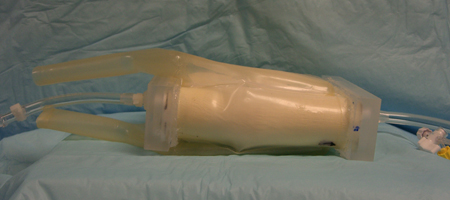Carnegie Mellon's Keith Cook Awarded $2.4M NIH Grant To Develop Artificial Lungs That Can Be Worn at Home
Contact: Daniel Tkacik / 412-268-1187 / dtkacik@andrew.cmu.edu
 PITTSBURGH—Carnegie Mellon University professor Keith Cook has received a four-year, $2.4 million grant from the National Institutes of Health (NIH) to support research and development of artificial lungs that patients may use long term in the comfort of their own homes while waiting for a lung transplant. Cook, an associate professor in the Department of Biomedical Engineering, will lead the project and collaborate with researchers from the University of Washington, Columbia University and Allegheny General Hospital in Pittsburgh.
PITTSBURGH—Carnegie Mellon University professor Keith Cook has received a four-year, $2.4 million grant from the National Institutes of Health (NIH) to support research and development of artificial lungs that patients may use long term in the comfort of their own homes while waiting for a lung transplant. Cook, an associate professor in the Department of Biomedical Engineering, will lead the project and collaborate with researchers from the University of Washington, Columbia University and Allegheny General Hospital in Pittsburgh.
"Far more people need a lung transplant or an artificial lung than what's available," said Cook, who noted that around 12 million people have chronic lung disease in the United States alone, but less than 2,000 people will be able to receive transplants. As a result, nearly 200,000 die from chronic lung disease every year.
For the last 20 years, Cook and other researchers have worked on artificial "bridge" lungs that support patients in need of a lung transplant who are placed on a waiting list. These devices have typically lasted days to a couple weeks before failure, and require close monitoring inside a hospital. Cook, now supported by the NIH grant, has been tasked with developing devices that last much longer and can be worn in homes.
"What got us this grant is that our initial results look very promising," Cook said. He said the initial results showed a substantial decrease in the formation of blood clots inside the artificial lung, one of the largest hurdles in building a reliable long-term device.
 "Anytime blood comes in contact with artificial material, it starts to clot," Cook explained.
"Anytime blood comes in contact with artificial material, it starts to clot," Cook explained.
One way in which Cook's team was able to decrease blood clots was through the design of the device. The fact that design was critical occurred to him about a year ago, when his team developed a novel design that prevented blood from pooling and forming clots. That device reached his team's goal of lasting two weeks without forming significant amounts of clotting, but Cook thinks it may have lasted up to a month if the team had lengthened its testing period.
Coatings on the device's artificial surfaces also can help fight clotting, and this will be Cook's focus under the NIH grant. To do this, the team must combine several coating techniques that mimic what human blood vessel cells — called endothelial cells — are doing to prevent blood clots. Once this is perfected, Cook believes the longevity of the artificial lung can increase to three months.
"That's the holy grail — three months," Cook said. "Two is probably acceptable, but for quality of life, you don't want a patient having to keep coming back to the hospital."
Cook believes that patients could be using one of these artificial lungs in the next five to 10 years.
"It was completely unheard of a few years ago, and there are people who will tell you it's unheard of now. I think it will happen, and I want to be the guy to do it," he said.
###
Keith Cook (pictured above) is aiming to create a "bridge" lung for patients that can last for three months. Cook says the design of the device (above) and the coatings on the surfaces are critical because they can help stop the formation of blood clots.